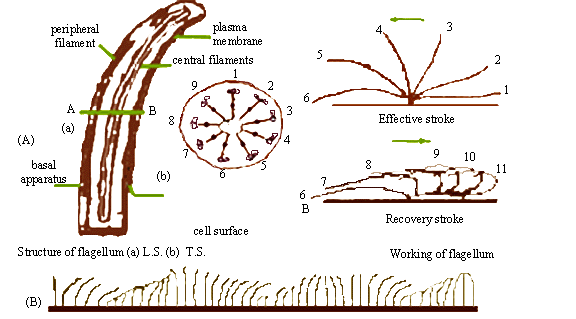|
PinkMonkey Online Study Guide-Biology
14.2 Kingdom : Protista
(Eukaryotic unicellular organisms)

Click here to enlarge
Figure 14.13 Some Protista
Protista includes all eukaryotic unicellular microorganisms,
either plant-like or animal-like or showing overlapping characters of
both plants and animals. Primarily they are aquatic and widely distributed
all over the world, occurring in oceans, lakes, ponds and damp soils.
They are autotrophic or heterotrophic. The latter are free-living or parasitic
on or within multicellular organisms. Thus it reflects the lifestyles
either of plants, animals or fungi. Phylogenetically they serve as the
connecting link between prokaryotic Monera and complex multicellular kingdoms
of plants fungi and animals. They are distinguished by the following characters:
(i) They are first eukaryotes, having a well organized
nucleus and complex membranous organelles.
(ii) They are unicellular or colonial forms without distinct division of labor.
(iii) They are autotrophic or heterotrophic showing
varieties of metabolic systems.
(iv) Locomotion is by pseudopodia, flagella or cilia.
(v) They show mitosis, meiosis and simplest type of sexual
reproduction for the first time. Common examples are Ameba,
Paramecium, Euglena, diatoms and dinoflagellates.
1. Cilia and flagella

Click here to enlarge
Figure 14.14 Cilia and Flagella
(A) Structure (B) Movement
These are microscopic, contractile, motile hair-like
locomotary organelles present in ciliated and flagellated protists like
Paramecium and Euglena. Cilia and flagella are similar in
structure. Each arises internally from the basal body and is made
up of eleven microtubules, two single ones in the center connected to
nine double ones arranged along the periphery (often referred to as 9
+ 2 arrangement). The outer fibrils enter cytoplasm and converge to form
the basal body. The central fibrils are connected to the peripheral ones
by radial lamellae, like the spokes of a wheel. Cilia are short and numerous
and beat in a coordinated manner simultaneously or one after the other,
while flagella are long and whip-like, showing undulating movements.
Their function is to propel the cell through the surrounding liquid medium
or move the surrounding medium past the cells, gathering food particles.
During movements cilia beat vigorously and rapidly (effective stroke)
and they recover slowly (recovery stroke). Cilia and flagella are widely
distributed in gametes, unicellular plants and animals and also on cells
of more complex organisms forming the internal lining of ducts, such as
trachea, oviduct, etc.
|
Table of Contents
14.0
Introduction
14.1 Kingdom
: Monera
14.2 Kingdom : Protista
14.3 Kingdom : Plantae
14.4 Kingdom : Fungi
Chapter
15
|